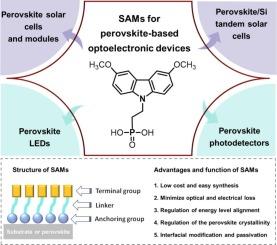Versatile self-assembled monolayers for perovskite-based optoelectronic devices
IF 22
1区 材料科学
Q1 MATERIALS SCIENCE, MULTIDISCIPLINARY
引用次数: 0
Abstract
The emergence of metal halide perovskite materials has triggered a revolutionary change in optoelectronic devices. Due to their outstanding optoelectronic properties and defect tolerance, metal halide perovskites can be used for a wide range of applications, including perovskite solar cells (PSCs), perovskite light-emitting diodes (PeLEDs), and perovskite photodetectors. However, the performance of perovskite-based optoelectronic devices is constrained by severe charge recombination at the interfaces between the perovskite film and charge transport layers. Self-assembled monolayers (SAMs) are attractive for addressing these interfacial issues. SAMs exhibit notable cost-effectiveness while providing superior optoelectronic characteristics, with potential for enhancement via tunable molecular engineering and optimization of ion–dipole interactions. Here, we review the recent advances of SAMs in perovskite-based optoelectronic applications by elucidating their role and function in different devices. Then we summarize the structure–function-performance relationships between SAMs and devices based on recent research. Finally, we provide a perspective on the role of SAMs in promoting practical applications by effectively improving the interfacial properties of perovskite-based optoelectronic devices.

用于钙钛矿基光电器件的多功能自组装单层
金属卤化物钙钛矿材料的出现引发了光电器件的革命性变化。由于其出色的光电性能和缺陷容忍度,金属卤化物钙钛矿可用于广泛的应用,包括钙钛矿太阳能电池(PSCs),钙钛矿发光二极管(PeLEDs)和钙钛矿光电探测器。然而,钙钛矿基光电器件的性能受到钙钛矿膜和电荷传输层之间界面处严重的电荷复合的限制。自组装单层膜(sam)在解决这些界面问题方面很有吸引力。SAMs具有显著的成本效益,同时提供卓越的光电特性,具有通过可调分子工程和优化离子偶极子相互作用来增强的潜力。在此,我们通过阐明其在不同器件中的作用和功能,综述了sam在钙钛矿基光电应用中的最新进展。在此基础上,对近年来的研究成果进行了总结。最后,我们通过有效改善钙钛矿基光电器件的界面特性,对sam在促进实际应用中的作用进行了展望。
本文章由计算机程序翻译,如有差异,请以英文原文为准。
求助全文
约1分钟内获得全文
求助全文
来源期刊

Materials Today
工程技术-材料科学:综合
CiteScore
36.30
自引率
1.20%
发文量
237
审稿时长
23 days
期刊介绍:
Materials Today is the leading journal in the Materials Today family, focusing on the latest and most impactful work in the materials science community. With a reputation for excellence in news and reviews, the journal has now expanded its coverage to include original research and aims to be at the forefront of the field.
We welcome comprehensive articles, short communications, and review articles from established leaders in the rapidly evolving fields of materials science and related disciplines. We strive to provide authors with rigorous peer review, fast publication, and maximum exposure for their work. While we only accept the most significant manuscripts, our speedy evaluation process ensures that there are no unnecessary publication delays.
 求助内容:
求助内容: 应助结果提醒方式:
应助结果提醒方式:


